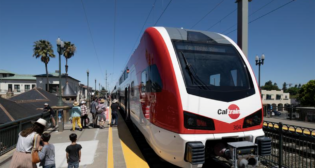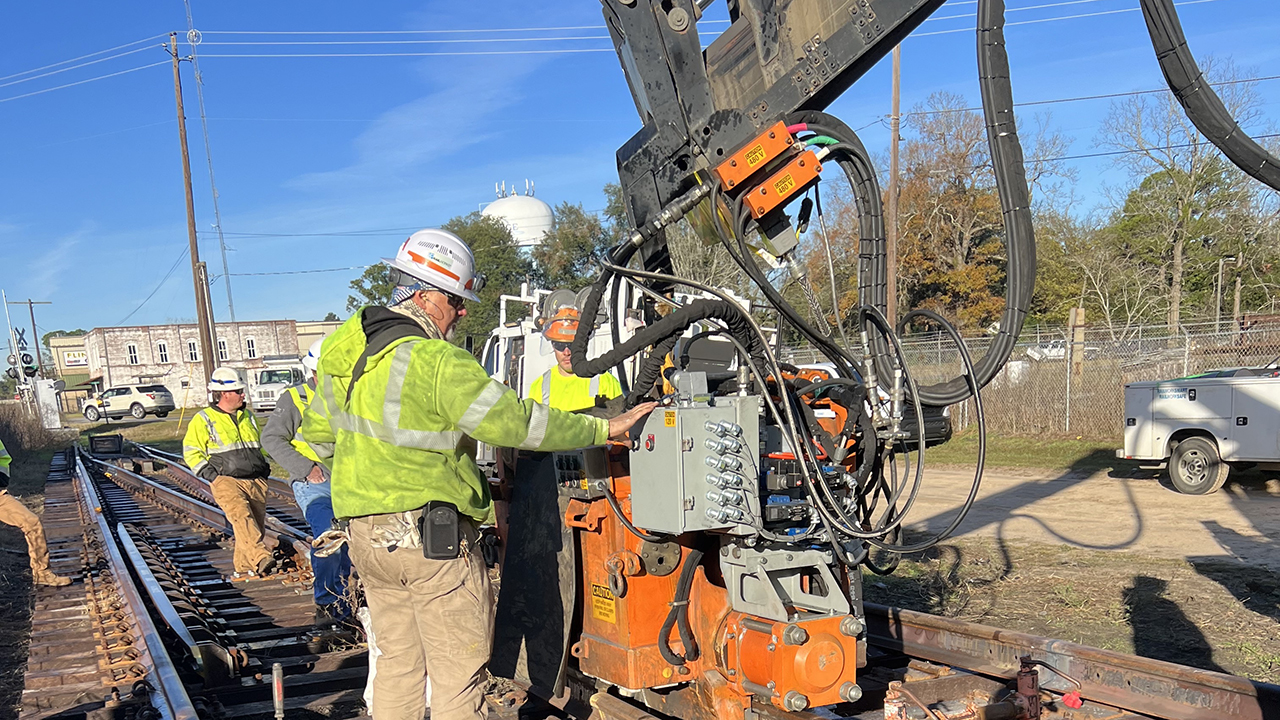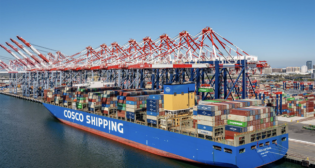
Rail Life Extenders
Written by Marybeth Luczak, Executive Editor
RailWorks’ new Narrow Head Flash Butt Welding Boom Truck. Railworks photo.
RAILWAY AGE, MAY 2024 ISSUE: Milling, grinding and welding maximize return on
one of the railroads’ biggest investments—rail. Suppliers are continually refining their grinding, milling, and welding equipment and services to extend rail and track component life, prevent premature rail failures or replacement, improve ride quality, and boost fuel savings. The following companies offered Railway Age insight on the market and shared their latest technologies for heavy-haul and passenger railroad maintenance.
Plasser American

Full rail treatment service provider Plasser American tells Railway Age that it promotes grinding and milling as complementary technologies. “Where grinding has an advantage for preventive maintenance with low to medium metal removal, milling covers the area of medium to high metal removal,” the company explains. “Of course, there is some overlap in the medium metal removal area where either technology can be economically used. In such a case, Plasser American can guide the customer though the selection process.” Rail milling, it adds, can “efficiently and economically remove deep defects and fully restore the rail profile thereby preventing premature rail exchange.”
Plasser American’s hybrid milling machine for North America, the ROMILL Urban 3 E3, is said to reliably treat “challenging track conditions” and uses a post treatment system—HPP (High Performance Polishing)—to provide a low-noise surface finish, where required, the supplier says. “The hybrid drive system allows for three-hour battery-only operations with no emissions—no exhaust fumes, no sparks, no dust—and low operational noise,” according to Plasser American. “The integrated Tier 4F [Final] diesel-generator can act as a quick charger during milling operation. In addition, the machine can be charged externally.”
The supplier recently teamed with Switzerland-based rail maintenance equipment manufacturer Speno International. In addition to serving as the exclusive agent for Speno in North America, Plasser American will provide grinding services to the North American market. “Speno grinding technology differentiates from conventional grinding technology through several key aspects: improved grinding quality (not just creating sparks but fully achieving target profiles and target metal removal); increased fire safety through a combination of shielding and water cannons/sprinkler systems; improved cleanliness through superior dust collection systems; and grinding support systems that interact with integrated measurement technology to improve overall quality and productivity by reducing operator subjectivity,” according to Plasser American, which notes that it will provide “efficient and economic preventive rail maintenance to maximize rail life and cost savings for North American railroads.”
Loram Maintenance of Way, Inc.

This year, Loram will be rolling out its latest rail grinder, RGX, in 20-, 30- and 40-stone configurations. After four years of development, the machine will offer a smaller footprint—ideal for transit agency work—as well as redundancy with multiple engines and traction systems, according to Product Manager-Rail Chris Lidberg. It will be completed this month and enter the testing phase, before joining Loram’s North American fleet. A second RGX is being built for European applications and will be ready for service in 2025.
Also entering service this year is Loram’s first rail miller for heavy corrective work. In partnership with Linsinger Maschinenbau Gmbh, Loram will be providing what it calls a “Zero-emissions/hybrid milling machine.” A second unit will begin operating by third-quarter 2025.
Lidberg tells Railway Age that customers continue to seek increased speed and efficiency of maintenance-of-way (m/w) activities, with a focus on “turning data into actionable information that can improve m/w planning.” In 2023, the company introduced Loram VR (Virtual Rail), which uses a railroad’s inspection data to help design a grinding program.
Additionally, heavy-haul and passenger rail customers want to improve m/w safety while reducing track occupancy time, Lidberg reports. That’s among the reasons why Loram recently partnered with Rail Vision to pilot its AI-driven Shunting Yard System in rail grinding operations. The system will improve vision at night, when most grinding work is conducted, and help identify if a switch is positioned properly, for example. “It’s about bringing additional situational awareness to our operator and improving decision-making,” Lidberg says. The pilot is slated to begin in June and run for several weeks.
Holland Company
Demand for flash butt and thermite welding services is up again this year, Executive Vice President-Business Development Russell Gehl tells Railway Age. “With money coming through the federal Infrastructure Investment and Jobs Act, we are picking up more work from Class I’s, short lines and regionals,” he reports. “More railroads are taking advantage of cut and slides and repair welding through grants.” Gehl notes that the uptick in business also comes from labor shortages at railroads.
Holland is currently building new flash butt welding trucks and making upgrades to existing trucks’ pullers and control systems. Its newest technology under development is a battery-operated flash butt welder, which is being demonstrated at MxV Rail in Colorado. Rather than employing a larger gen-set to make welds, it uses a smaller, lighter battery, according to Gehl. The company’s aim, he says, is to develop smaller, lighter flash butt welder systems to provide flexibility for use in tunnel or tight applications or in densely populated areas where less noise is required for night work.
Holland also has a prototype dubbed the 4.1 truck model, which Gehl says is a four-man, fully contained rail welding gang in one truck that is able to carry “seed rail” to replace a defect or joint, as well as longer rail sections for curve replacement. “The philosophy behind this is to reduce the gang size and operate fewer trucks to be nimble,” Gehl explains. The 4.1 is expected to enter pilot revenue service this month.
On the safety side, Holland has invested in San Francisco, Calif.-based Samsara’s forward- and inward-facing camera systems that are used on its welding trucks to help operators improve over-the-road and in-the-field driving. It is also piloting “red-zone” technology to help prevent weld gangs from entering dangerous areas, such as roller lines.
Holland continues work on Mexico’s Tren Maya project, with upwards of 150 employees performing welding work, and, “like everyone, we are preparing for Brightline West,” he says, the $12 billion, 218-mile high-speed rail project linking Las Vegas and Southern California. “We had a significant role in Brightline’s South Florida project, and expect to play a role in the West,” he says. The company is also building welders for high-speed rail in India and Japan, as well as container welders for shipment this year to the international market.
RailWorks Maintenance of Way LLC
RailWorks continues to see growth in the grinding and welding market, according to Vice President and General Manager Jason Deaton. This year, the company introduced the Narrow Head Flash Butt Welder, which it has put to use for several Class I customers with positive feedback. Deaton says it’s unique in that it can work in tight clearance areas and around switches. “It can fit in and around the frog section of a turnout and get those four tight welds that are normally performed by thermite welding,” he explains. “This unit is allowing us to get the entire turnout completed utilizing our flash butt welding service.” Among its specs: 60-ton weld head, 3.5 inches of stroke, 8.5 inches of required clearance, standard Chemetron control system, forge to refusal, and Hiab crane 25-foot reach. Also this year, RailWorks rolled out remote monitoring on its flash butt welding trucks. On the transit side, the company has been doing more grinding work, including grinding planning and analysis.
RailWorks also offers track geometry services, and recently debuted a hitch-mounted system, which can be used on any hi-rail vehicle with an existing receiving hitch. “You fire it up and everything’s remote into the truck, on the laptop, and there’s no wires,” Deaton says. Data, he points out, is key to customers today. “Track geometry curve data, for example, has been really important in the past few years,” Deaton tells Railway Age. “And the reason is because customers like knowing their degree of curve—where the curve is starting, where the point of radius, point of tangent, where all those points start and end. And we’re providing accurate GPS coordinates to all of that. Customers can compare those to their ‘as-built’ information—where the curve was when the track was first installed.”
Orgo-Thermit Inc., A Goldschmidt Company
Orgo-Thermit has an eddy current service, which allows it to perform measurements of up to three millimeters below the rail surface, to better understand rail condition. In the past year, the company has been using it for a number of customers, according to Michael Madden, President of North American Operations. The data provides a comprehensive picture of rail condition and helps users develop customized grinding plans so they can address “problematic” track areas, he says. “This way, if there are areas that don’t need attention, we are not unnecessarily grinding them.”
On the thermit welding side, Orgo-Thermit plans to introduce several new products at the American Railway Engineering and Maintenance-of-Way Association’s 2024 Conference & Expo this September.



